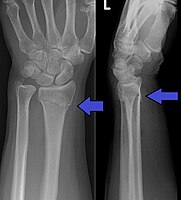
Photo from wikipedia
BACKGROUND: The fractures of the distal radius are one of the most frequent cases in the pediatric population. The primary way of treating these fractures is conservative, with manual reduction… Click to show full abstract
BACKGROUND: The fractures of the distal radius are one of the most frequent cases in the pediatric population. The primary way of treating these fractures is conservative, with manual reduction and cast immobilisation. In patients where reduction and retention of the fracture cannot be achieved, a surgical approach is the treatment of choice. AIM: To evaluate the benefits of using the minimally invasive surgical treatment of closed reduction using Sommer - pins in the treatment of the fractures of the distal radius in the pediatric population with the method of the Kapandji technique. MATERIAL AND METHODS: In this study, we used cases treated from 2012 to 2017, of 48 completely dislocated fractures of the distal radius in patients ages 6 -14 yrs., where the use of non-surgical treatment proved ineffective. In the surgical treatment, we used one or two Sommer - pins to achieve a correct reduction and fixation. RESULTS: The post-op immobilisation lasted 4 - 7 weeks with an underarm cast. The patients were closely followed in the period of 6 months following the intervention. The anatomic reduction was easily achieved with this type of technique in every case. In the post-op period, there was no significant loss of reduction and another surgical procedure was not needed in any of the cases. CONCLUSION: With the use of the closed reduction Kapandji technique, an easy and good anatomical reduction is achieved with good post-op results in the treatment of completely dislocated fractures in the distal radius in children.
Journal Title: Open Access Macedonian Journal of Medical Sciences
Year Published: 2018
Link to full text (if available)
Share on Social Media: Sign Up to like & get
recommendations!